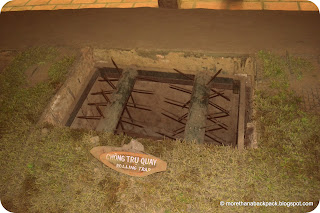29 March 2012
Every year, my family from the mother’s side would spend a short vacation together. For the past couple of years, I haven’t been able to join the annual vacation but this year, my schedule (or my lack of a schedule) permitted me to join them. And this year, we all went to the former capital of Vietnam… formerly known as Saigon… Ho Chi Minh City.
Every year, my family from the mother’s side would spend a short vacation together. For the past couple of years, I haven’t been able to join the annual vacation but this year, my schedule (or my lack of a schedule) permitted me to join them. And this year, we all went to the former capital of Vietnam… formerly known as Saigon… Ho Chi Minh City.
When we arrived, the first thing everyone noticed was that Facebook was blocked. Haha!  After we have settled in, our tour guide
Nguyen suggested that we have lunch at Pho 2000. US President Bill Clinton once
visited this restaurant and you could see a photo of him with the restaurant
staff mounted on the wall, inside the restaurant.
After we have settled in, our tour guide
Nguyen suggested that we have lunch at Pho 2000. US President Bill Clinton once
visited this restaurant and you could see a photo of him with the restaurant
staff mounted on the wall, inside the restaurant.
 |
| Pho 2000 restaurant |
One thing distinct about Vietnam is its traffic, which was mainly composed of motorcycles. As we rode the tour bus around the city, I noticed all sort of Vietnamese iin motorcycles: women in business attires, men carrying bulky items and a family of 3 in one motorcycle. Their helmets look like hats, some with cute designs, with not a lot of padding in it.
 |
| Vietnamese Traffic |
Our hotel, the Blue Diamond Hotel, was conveniently located a few blocks
away from one of Vietnam’s market, Cho Bến Thành. From flowers and fruits to
fake bags and local clothes, you can find all these in the market. Cheaper
goods sold wholesale can be found at another market, Cho Bình Tây at the Chinatown.
Fake but relatively good quality bags are supposedly cheap in Vietnam. However,
I don’t know much about bags or shopping so I can’t verify that.
 |
| Cho Binh Tay |
Our second day started with the famous Cu Chi Tunnels. The tour brought us to the complex underground tunnels. Some of the entrances and exits were so small that you have to be quite skinny to fit into them. There were also different sorts of hidden traps that look like they were from a horror movie.
 |
| Secret entrance to the tunnels |
 |
| A rolling trap |
After the Cu Chi Tunnels, we spent an hour at the War Remnants Museum (Bảo tàng chứng tích chiến tranh).
The museum exhibits documentary photos during the Vietnam wars. It shows the
sad consequences of the war: innocent civilians mutilated by chemical weapons
and malnourished prisoners. A number of photos were quite grotesque; they tell the stirring stories of the victims.
 |
| War Remnants Museum |
Our last destination for the day was at the Independence Palace (Di Tích Lịch Sử Dinh Độc Lập), which
used to be South Vietnam’s presidential palace. Today, it’s a historical relic
and a venue for government events. I find the basement the most interesting
part of the palace. There, you can find the President’s war room, vintage
telephones, radios and typewriters.
 |
| Independence Palace / Reunification Palace |
On our third day in Vietnam, we had a half day tour at Mekong Delta.
Before reaching the green and muddy village of Mekong, we rode a motorized boat along the Mekong River. The village was quite tourist oriented. Tropical
fruits and drinks were served, there was a Vietnamese lady singing in costume
and local souvenirs. My favorite part at Mekong was riding a small boat at the
river, manually paddled by women wearing nón lá hats, the Vietnamese conical
hat.
 |
| Riding a boat at the Mekong River |
The Vietnam war had made a poignant affect to the country. Vietnam was the first communist country I've been to. Ho Chi Minh may not have the amazing temples of Bangkok or the amazing beach of Boracay, but it is in a country where you can easily be a millionaire (1 Million VND≈ 50 USD).
29 March 2012 ETD 07:15 ETA 08:55
01 April 2012 ETD 15:30 ETA 19:10










